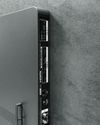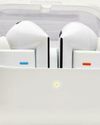
The LS3/5A were never meant to be heard by the public. The iconic BBC speakers were born out of the broadcaster’s research and development department in the 1970s, whose engineers were tasked with designing and creating broadcasting equipment that the BBC needed but couldn’t source from external suppliers. In this instance, they were after highly accurate small monitors that could be used in the limited space within the outside broadcast vans.
Nothing commercially available at the time was good enough for the BBC’s needs, so the engineering division invested in a huge amount of research to find out what makes a good sound in speakers.
Until this point, the concept of a small hi-fi speaker didn’t exist. You’re looking at fairly large cabinets for your average speaker before the ’70s; the LS3/5A were attempts to get very high-quality sound out of shoebox-small nearfield monitors. Many of history’s successful small speakers, such as the Linn Kan, the Neat Petite and models by Spendor and Harbeth, owe their existence to these original LS3/5As. The BBC never actually made these speakers, but licensed out the specifications to various manufacturers, including Rogers Hi-Fi, Falcon Acoustics, Chartwell, Goodmans, Stirling, KEF and Spendor, while Musical Fidelity’s versions are inspired by those original R&D specs.
Those research findings
This story is from the {{IssueName}} edition of {{MagazineName}}.
Start your 7-day Magzter GOLD free trial to access thousands of curated premium stories, and 9,000+ magazines and newspapers.
Already a subscriber ? Sign In
This story is from the {{IssueName}} edition of {{MagazineName}}.
Start your 7-day Magzter GOLD free trial to access thousands of curated premium stories, and 9,000+ magazines and newspapers.
Already a subscriber? Sign In

Bose QuietComfort Ultra Earbuds
Out with the old Bose and in with the new

Sony Bravia 8 (K65XR80)
Can the Bravia 8 pick up where the awesome A80L left off?

Philips OLED809 (650LED809)
The Philips OLED809 is a great mid-range OLED TV designed for the masses

LG C4 (OLED65C4)
LG's C-series is back on top

Tidal
The best music service for streaming-savvy audiophiles

Spotify
Is Spotify still the world's best music streaming service?

Apple Music
Apple aces many things, but is streaming music one of them?

Amazon Music Unlimited
A solid streaming service to rival Apple Music and Spotify

Apple AirPods Pro 2
Are these the best-sounding AirPods?

Samsung Galaxy Buds 3 Pro
Samsung sends the Galaxy on a quest to outdo Apple and co